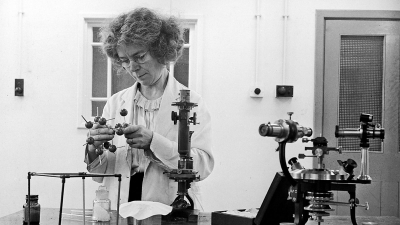
In 1923, W.H. Bragg left for the Royal Institution in London and Kathleen went with him. It was around this time that X-ray crystallography began to be used to look inside organic molecules — carbon atoms with other elemental atoms attached. The process involved a lot of calculations, and Kathleen saw the need for crystallography look-up tables that would greatly speed things up. Together with her lab-mate, they created the Astbury-Yardley tables, which formed the basis for what became the International Tables for X-ray Crystallography.
While at the Royal Institution, Kathleen met Thomas Lonsdale, an engineering student who would become her husband. They married in 1927 and then moved to Leeds to accommodate his new job. Meanwhile, Kathleen joined the University of Leeds’ physics department and worked on X-ray diffraction.
It was at the University of Leeds that Kathleen made a name for herself. Chemists had been arguing about the atomic structure of benzene for decades. In 1865, chemist August Keuklé had a dream that included a vision of the structure of benzene. He saw atoms dancing around and transforming into an ouroboros — a serpent swallowing its own tail. Kathleen was given hexamethylbenzene crystals to study, and in 1929 she was able to prove conclusively that the benzene molecule is in fact a flat ring. This was a remarkable achievement, especially considering that all the calculations had to be done by hand. And as if that wasn’t enough of a contribution, Kathleen was also the first to apply Fourier methods to X-ray pattern analysis as she solved the structure for another type of benzene — hexachlorobenzene.
Kathleen’s first child, Jane, arrived later that same year. The family soon moved back to London and had two more children in 1931 and 1934 — Nancy and Stephen. Although moving and raising children greatly disrupted Kathleen’s work, she kept her head in the crystallography game, doing calculations of structure factors by hand whenever she had the time. Soon, Sir Bragg shared good news: he’d been given an allowance so that Kathleen could hire a nanny and come back to work at the Royal Institution.
When Kathleen returned, there were no X-ray instruments available to her. She was able to secure a large electromagnet instead, so she pursued another interest — determining the magnetic properties of benzene-like compounds known as aromatics. By doing this, she was able to establish proof of molecular orbitals, but another chemist, Linus Pauling, beat her to publication.
Credit : Hack a Day
Picture Credit : Google




